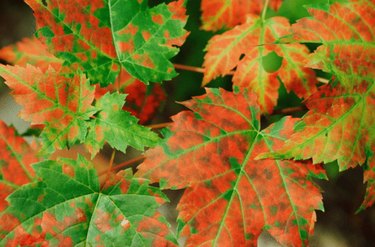
Just like humans, trees can have long lives with captivating stories to tell. The maple tree life cycle (Acer, USDA plant hardiness zones 2 to 10) is especially interesting. There are about 200 species of these trees, including red maples (Acer rubrum, USDA hardiness zones 3 to 9), which can take from 10 to 30 years to reach their full adult size. An analysis of maple tree growth stages reveals similarities from species to species.
The Maple Tree Life Cycle
Video of the Day
The particular stage of a maple tree's life cycle at any given time is largely dictated by the season. In the autumn, a maple tree's green leaves turn yellow, orange and red before dying and falling to the ground. The tree is dormant during the winter, and in the spring you will see bright red buds on the branches; these turn into flowers. There are male flowers with stamens that produce pollen, which is broadcast on the female flower stalks, or stigma.
Video of the Day
This pollination creates two seeds for every female flower, and an inedible fruit (samara) grows around the seeds. When the leaves come out, the samaras start to grow into "wings," which are shaken from the tree by the wind. You can see them spinning down to the ground during this time. Many children call these "helicopters." Once they take root in moist ground, they will sprout in days into seedlings.
As the seedling grows, more leaves sprout, making food for the plant. As it grows into a tree, the trunk gets taller and thicker, with new branches forming. Twigs then appear, producing more leaves. The maple tree life growth stages start over every spring with new leaves, flowers and seeds.
Older Maple Trees
Maple trees usually grow about 10 feet during their first decade. You can determine the age of a maple tree using a few basic supplies. To do so, you will need to know the type of maple in question, plus have a measuring tape and a rope on hand. Measure up the trunk 54 inches and tie a rope around the trunk at that point. Now, use the measuring tape to determine the circumference of the tree (wrap the tape around the tree's trunk).
Divide that circumference by pi (3.14), and this will give you the diameter. Multiply that diameter by the growth factor number specific to the species of maple that you have. For a silver maple (Acer saccharinum, USDA zones 3 to 9), multiply by 3; for a red maple, multiply by 4.5, and for a black maple (Acer nigrum, USDA hardiness zones 6 to 8), multiply by 5.
If you have a sugar maple (Acer saccharum, USDA hardiness zones 3 to 8), multiply by 5.5. For a Norway maple (Acer platanoides, USDA hardiness zones 3 to 7), multiply by 4.5. This will give you a good estimate of the maple tree's age.
Additional Age Determination Techniques
Another way to determine age is to have a good look at the bark of the tree. As with human skin, bark changes with age. Take the sugar maple: its bark becomes disheveled and loosened over time.
Do some research on the species to determine how the aging bark changes. You can also use an online tree age estimator, like those shared by the Town of Clifton Park. Select the type of tree, enter its circumference in inches and the calculator will estimate your tree's age.